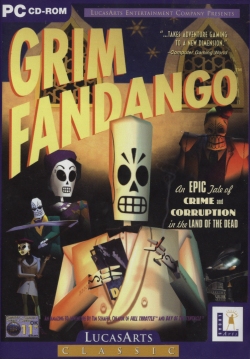
| Grim Fandango | |
|---|---|
| Developer(s) | LucasArts |
| Publisher(s) | LucasArts |
| Year released | |
| System(s) | Windows |
| Designer(s) | Tim Schafer |
|---|---|
| Genre(s) | Adventure |
| Modes | Single player |
| Rating(s) |
Grim Fandango is a graphic adventure computer game released by LucasArts in 1998 and primarily written by Tim Schafer. It was the first adventure game by LucasArts to use three-dimensional graphics overlayed on pre-rendered 2D computer backgrounds. As with other LucasArts adventure games, the player must converse with other characters and examine, collect, and use objects correctly to solve puzzles in the game in order to progress.
The game received positive reviews, which praised its artistic design and overall game direction in particular. Grim Fandango was selected for several gaming awards at the time of release, and is often listed in publishers' lists of top games of all time. However, the game has been considered a commercial failure, which partially led LucasArts to terminate their adventure game development, contributing to the decline of the adventure game genre.
Grim Fandango's world combines elements of Aztec beliefs of afterlife with style aspects of film noir, including The Maltese Falcon, On the Waterfront and Casablanca, to create the Land of the Dead, which recently departed souls, represented in the game as calaca-like figures, must travel through before they reach their final destination, the Ninth Underworld. The story follows travel agent Manuel "Manny" Calavera as he attempts to save Mercedes "Meche" Colomar, a newly arrived but virtuous soul, during her long journey.